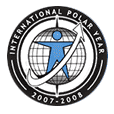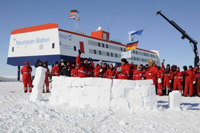
Polar areas have always interested both scientists and adventurers for their remoteness and harsh climate, but in recent years it has become clear that the Arctic and Antarctic play a significant role in the earth's ecosystem and are in a keyrole to both predict the impact of climate change and bear the consequences of it.
International Polar Year (IPY) is an international cooperative research initiative first introduced in 1882, with an objective to provide scientific information about the fundamentals of meteorology and geophysics as well as further people’s knowledge on the Polar Regions. Due to the fact that the IPY webpage has recently been relocated and updated by the Arctic Portal we have decided to overview the history of the IPY and some of the good work carried out by the IPY and it's programs.
Short History of the IPY
The initial idea of international cooperative polar research came from an Austro-Hungarian explorer and naval officer Lt. Karl Weyprecht who was a scientist and co-commander of the Austro-Hungarian Polar  Expedition of 1872-74. Weyprecht realised that a comprehensive polar research could not be a task of one nation only, but should involve a coordinated international effort. He recognized that a time of mere geographical discovery had past and a series of coordinated expeditions dedicated to scientific research should be undertaken to further peoples understanding on fundamentals of meteorology and geophysics. Unfortunately, he died before the international research became a reality, but his inspiration led to an establishment of the largest coordinated series of scientific expeditions ever undertaken in the Arctic during the 19th century, or to what is now known as the First International Polar Year.
Expedition of 1872-74. Weyprecht realised that a comprehensive polar research could not be a task of one nation only, but should involve a coordinated international effort. He recognized that a time of mere geographical discovery had past and a series of coordinated expeditions dedicated to scientific research should be undertaken to further peoples understanding on fundamentals of meteorology and geophysics. Unfortunately, he died before the international research became a reality, but his inspiration led to an establishment of the largest coordinated series of scientific expeditions ever undertaken in the Arctic during the 19th century, or to what is now known as the First International Polar Year.
First International Polar Year, 1881-1883
Eleven nations took part in establishing fourteen principal research stations across the Polar Regions. Twelve research stations were located in the Arctic, along with at least 13 auxiliary stations, and two in the Antarctic. A vast amount of information was gathered between 1881 and 1884, but in the lack of a centralized coordination of analysis and publication of the results no fundamental discoveries were made as a result of the first IPY. Each state published their observations independently and the International Polar Commission dissolved in the aftermath of the project.
Nevertheless, the First International Polar Year demonstrated that joint international scientific research was possible and set a precedent for the coming international scientific events.
Second International Polar Year, 1932-1933
The Second International Polar Year was both proposed and promoted by the International Meteorological Committee. The main objective of the second research initiative was to investigate the

global implications of the newly discovered “Jet Stream” and to conduct magnetic, auroral and meteorological observations at a network of research stations in the Arctic and Antarctic. Some 40 countries participated in the establishment of 40 permanent observation stations in both Arctic and Antarctic. Following, the data collected during the two-year period became the foundation of the International Meteorological Organization and promoted further research, such as the International Geophysical Year (IGY), 1957-1958, often called the third International Polar Year, which celebrated the 75th and 25th anniversaries of the First and Second IPYs.
Third International Polar Year, 2007-2008
 The latest International Polar Year, organized through the International Council for Science (ICSU) and the World Meteorological Organization (WMO), took place in 2007-2008. It was gigantic international multidisciplinary collaborative with around 10 000 scientists and 50 000 other participants from over 60 countries. Main objectives of this megaproject were to significantly increase the scientific knowledge and understanding of the polar areas, especially the wide-ranging and significant impacts of climate warming in the Arctic and Antarctic, and to conduct research projects beyond the resources of individual countries. In addition, the Polar Year aimed at educating a new generation of polar scientists and engineers and raise awareness of the public and policymakers of the importance of the polar areas for the entire planet. The disciplinary breadth of the third IPY far exceeded the previous Polar Years of 1882, 1932 and the 1957 IGY providing more comprehensive picture of the polar areas.
The latest International Polar Year, organized through the International Council for Science (ICSU) and the World Meteorological Organization (WMO), took place in 2007-2008. It was gigantic international multidisciplinary collaborative with around 10 000 scientists and 50 000 other participants from over 60 countries. Main objectives of this megaproject were to significantly increase the scientific knowledge and understanding of the polar areas, especially the wide-ranging and significant impacts of climate warming in the Arctic and Antarctic, and to conduct research projects beyond the resources of individual countries. In addition, the Polar Year aimed at educating a new generation of polar scientists and engineers and raise awareness of the public and policymakers of the importance of the polar areas for the entire planet. The disciplinary breadth of the third IPY far exceeded the previous Polar Years of 1882, 1932 and the 1957 IGY providing more comprehensive picture of the polar areas.
IPY legacy
Learning from the previous IPYs and from the lack of continuity between the IPYs, it was decided that this time the outcome of the immense research should be captured in a form accessible to all. It was also clear to the participants, that the polar areas were such large and important for the earth’s ecology that the research could not only be conducted in short random periods, but it should be continuous process of information collection, implementation and education.
What has become an IPY legacy includes activities such as observatory and research programs in the Polar Regions, educational opportunities, student and early career researcher initiatives and data and information sharing programs. The IPY Legacy will foster the international scientific cooperation to a higher level and promote a wide scale scientific knowledge and information sharing for the benefit of the generations to come.
To learn more about the Third International Polar Year 2007-2008, please visit the IPY 2007-2008 homepage or read the IPY 2007-2008 Joint Committee Summary Report
To search the IPY projects, please visit the IPY Project Database
To learn more about the IPY scientific data, please visit the IPY Data and Information Services (IPYDIS)
